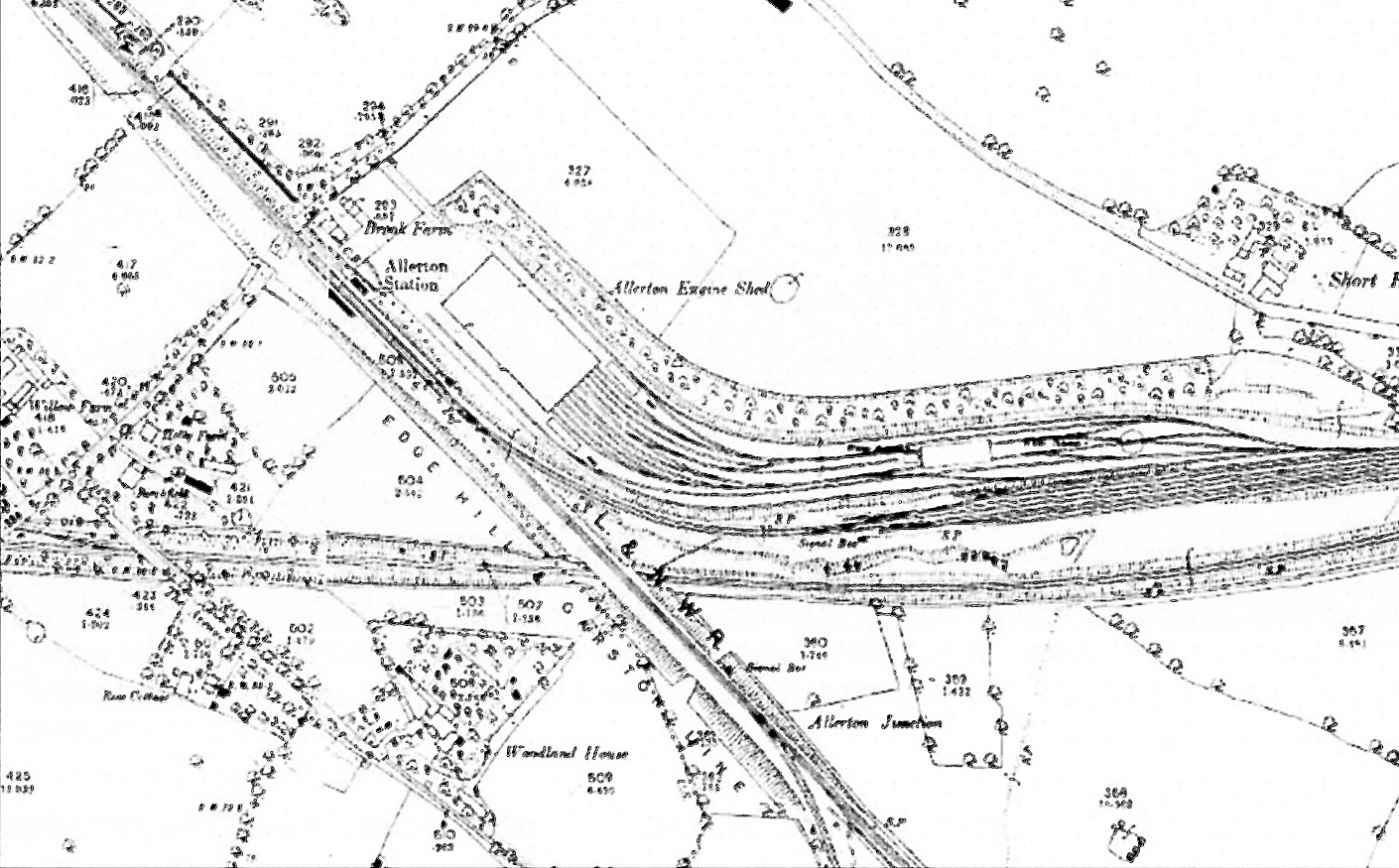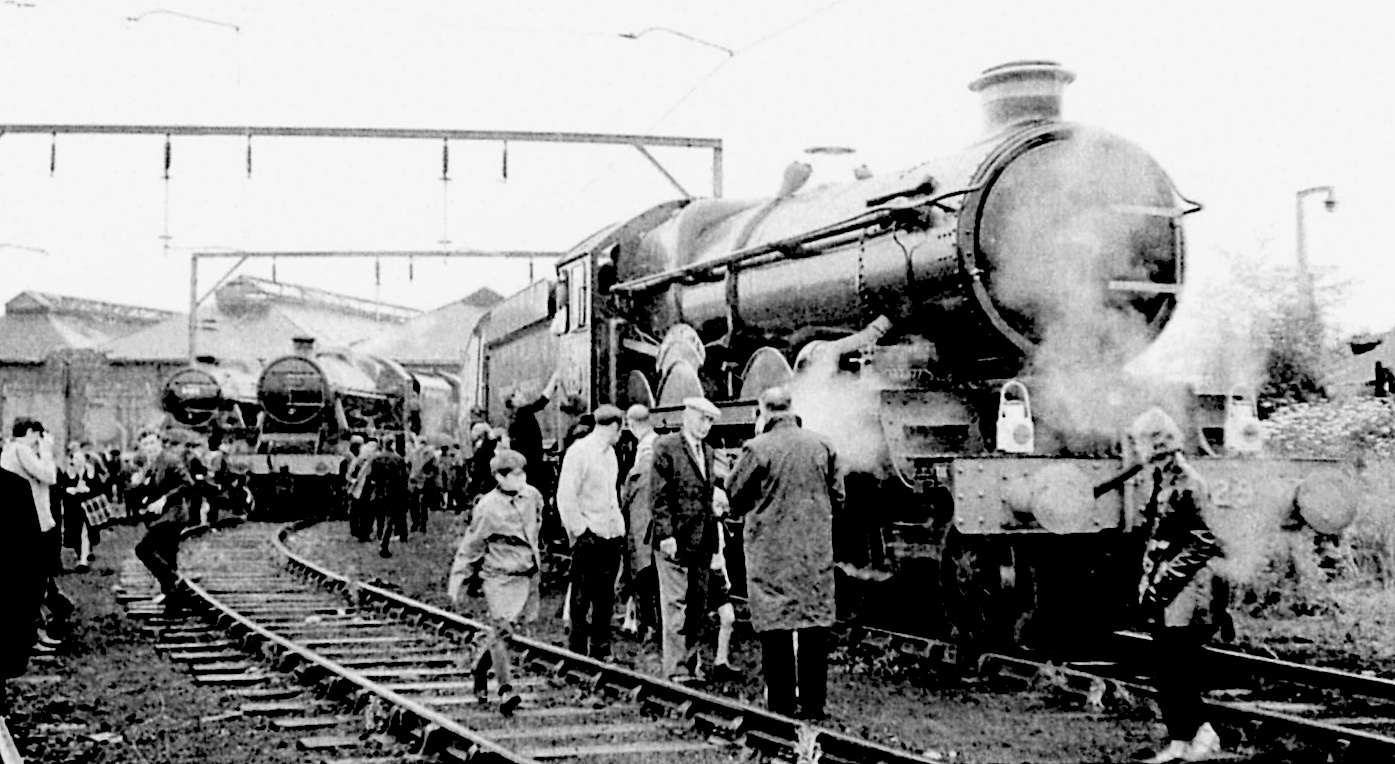
8D ASSOCIATION
The 8D Association is dedicated to promoting the history of the railways of South Lancashire, Merseyside and North Cheshire.
Allerton Traction Maintenance Depot
(Ex CLC, 8H, 8J & AN)
Pre British Railways History
Allerton Depot can trace its origins right back to the opening of the Cheshire Lines Committee (CLC) North Liverpool Extension Line in December 1879. The line had its connection with the CLC Liverpool and Manchester line at Halewood where a triangle and sidings were laid out. To serve the sidings at Halewood the CLC started to construct a locomotive depot at Allerton in 1880. The depot opened in 1882.
It was located on land to the north of the CLC main line to the east of the point where it passed under the London & North Western Railway (LNWR) Edge Hill and Garston line. Allerton station was to the west of the shed on the LNWR line.

The CLC did not own its own locomotives. The company was a joint concern with three partners, the Great Northern Railway (GNR), the Manchester, Sheffield & Lincolnshire Railway (MS&LR) and the Midland Railway (MR). By agreement the MS&LR provided the locomotives for CLC services and the majority of the engines at Allerton were from that company. The GNR and MR were also a presence though.
It seems that although the depot was constructed to serve the sidings at Halewood it was also used by locomotives from Liverpool. The main depot there for the CLC line was at Brunswick. It was on a cramped site with no room for expansion and Allerton considerably eased the congestion there. However by the mid-1890s the cost of light engine movements between Liverpool Central, Brunswick and Allerton was deemed to be prohibitive. By 1896 all of the MS&LR allocation of engines had been moved away from Allerton to other depots. The MR continued to use Allerton until 1897.
The shed became a wagon repair depot and carriage cleaning area. Very little changed at Allerton for the next sixty years. The CLC remained independent at grouping of 1923 but its owning companies became the London & North Eastern Railway (LNER) with two thirds of the shares and the London Midland & Scottish (LMS) with one third. At nationalisation Allerton became part of British Railways London Midland Region.
Post British Railways History
Big changes came at the end of the 1950s. In 1959/60 the connecting chord between the former CLC and LNWR systems was altered and new depot facilities were built on the north side of it where originally there had been a coaling plant and turntable. On 7 October 1961 the chord and the sidings within the new depot area were energised with 25KV overhead wires.
The works were associated with the electrification of the line between Liverpool Lime street and Crewe and with the introduction of DMUs onto the former CLC line. From 1960 Allerton had an allocation of class 115 four car suburban DMUs. The class 115s were allocated to Allerton to work express services between Liverpool Central and Manchester central. The depot was also given an allocation of class 108 DMUs which worked on local services from both Liverpool Central and Lime Street. From 1960 until 1963, it became a sub shed to Edge hill (8A) was given a shed code of 8H, then went to 8J until 1973. From 1973 it was officially allocated AN but this code was used prior to 1973 as far as it can be established.

The British Rail period
During the 1960s electric locomotives of the AL1 to AL6 (class 81 to 86) also visited Allerton depot for servicing as did the class 304 EMUs that worked trains between Liverpool Lime Street and Crewe. In July 1969 Allerton depot had an open day which attracted many thousands of visitors. Although steam had finished on British Railways the previous August, three steam locomotives visited Allerton for the open day. They were ex GWR 4-6-0 Castle Class, No 7029 ‘Clun Castle’, ex LMS 4-6-0 Jubilee Class, No 5593, ‘Kolhapur’ and Black 5, No 5428.

AL Class electric locomotives were also on display at the open day which was centred around the former CLC shed of 1882.
During the 1970s and into the 80s Allerton continued to be a busy depot providing the DMUs that by that time were running from Liverpool Lime Street only (Liverpool Central having closed on 17 April 1972). Diesel and electric locomotives were still regular visitors during that period. The depot also had an allocation of class 08 shunting locomotives that performed duties at various yards in the area such as Hutchinson Street in Widnes, Folly Lane in Runcorn and the yard at Warrington Central.
In the early 1980s a wheel lathe was installed at Allerton. It was located close to the point where the engine shed had been. In 1983 the CLC line between Garston and Hunts Cross was electrified with third rail as part of the Merseyrail Northern Line. A short section of line at the east end of the depot was electrified with third rail so that class 507 and 508 EMUs could come into Allerton for wheel turning. From the mid-1980s British Rail started to introduce its second generation DMUs and Allerton was not chosen as a depot at which they were to be based. Newton Heath in Manchester was home to most of the new units that were introduced onto services in the Liverpool area.
The class 115 DMUs had disappeared from Allerton by 1988 and the 108s had followed within a few years.
Privatisation period onwards
By the early 1990s Allerton was in decline. Freight wagons were serviced at the depot and the wheel lathe continued to be used. The depot passed to the English Scottish & Welsh Railway (EWS) freight company during the privatisation era but it continued to decline.
In 2007 EWS was taken over by the German rail freight company DB Schenker who assumed responsibility for Allerton. In April 2008 DB Schenker mothballed the depot and its future appeared uncertain. Amazingly the overhead wires remained energised despite the fact that the depot had started to be visited by local children and vandals. In August 2009 a 13 year old boy was killed when he climbed onto wagons that had been left at the depot. There was much criticism in the local media about the lack of security at the depot.
In 2010 plans were announced for the electrification of many lines in the North West including the routes between Liverpool and Manchester via Chat Moss and the Huyton to Wigan line. Northern Rail, the company that operated most of the local passenger services in the area, turned its attention to the mothballed Allerton depot as a suitable place to service class 156 and 150 DMUs as well as a base for the EMUs that would be deployed on the electrified routes.
Northern Rail (Serco-Abellio) in a joint project with Network Rail took over the depot in 2011 and a refurbishment costing £10.6 million was carried out over a six month period. The works were substantially complete by December 2011. Even the wheel lathe, which had been flooded out for a number of years, was brought back into use.
On 10 May 2012 Allerton was officially re-opened by Transport Minister Teresa Villiers. The opening of the new Northern Rail depot had created 46 jobs. In 2014/5 the first EMUs, Class 319’s for the Liverpool and Manchester electric services had transferred to Allerton from the London area. In March 2016, the rail franchise for the north west changed with Arriva Rail North (known as ‘Northern’) taking over along with the depot too.
During 2014 and 2015, a further upgrade of the depot took place were part of the main shed was extended along with associated electrification work. Since then the depot has been home to Class 319, Class 323 and the new CAF Class 331 emu’s. Clearly the depot has a good future ahead of it.
